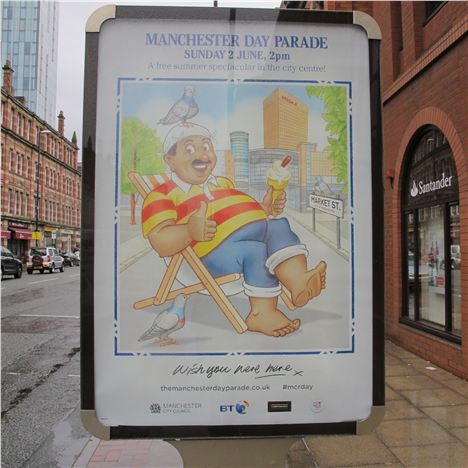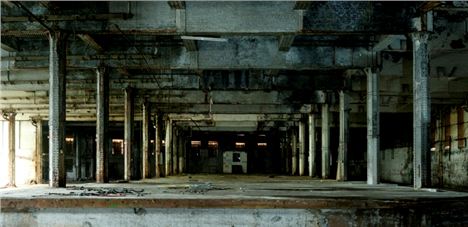“Original Modern has the demeanour and odour of a sleeping dog,” says Phil Griffin, Manc cultural commentator and occasional Confidential writer.
Let the Council make the old dog fetch a stick when they want, as with the twisted application of Original Modern to Manchester Day this year but being original and modern is “the essence of Manchester” as Spinoza says, and that doesn’t have to be explicit or underlined in red.
You can see what he means. But it used to be so different.
We were giddy about Original Modern when it was first mooted a decade ago. With Manchester’s pioneering past and optimism about the future, the Peter Saville creation seemed the ideal ‘controlling thought’ to lead us out of any remaining eighties and nineties drag.
It was a handy construct that showed while we were proud of our past achievements (see Significant City article here) we were looking forwards. Originality and modernity are timeless ideals and the international brand and design magazines lapped it up. It helped that Saville was already a design darling, suitably funky with his Factory Music connections and his work with bands such as Suede.
As Mancunians we saw Original Modern as fitting for the leading British provincial city. It was a notion that set us apart. Nobody baulked at the huge fee the London-based Saville received as consultant Creative Director to Manchester City Council. The glow from his £120k per annum illuminated us all.
The Original Modern 'M' for Manchester
That was then.
In 2013 the sleeping dog of Original Modern is roused every now and then to prove a point or show off our progressive credentials but otherwise the old beast is allowed to slumber, drowsing on the periphery of Manchester life.
“Original Modern came out of ‘city-time’,” contrinues Griffin, coining an expression as he speaks. “This started in the nineties and carried on into the 2000s. It was time when the nature of cities across the world were studied, talked about and examined in universities, companies, design practices and councils. It was a matter of constant debate. It was deafening. The result was a real renaissance of cities and Manchester shared in that.
“In the middle of all this constant ‘city-time’ noise - in our Great Gatsby moment - we had Peter Saville musing. Then in 2008, this renaissance ran out of funds. And now Original Modern doesn’t feel quite right, as though it’s had its day.”
Peter Saville musing
Yet Phil Griffin underlines the one undeniably “good thing” that has emerged from Original Modern.
“The main manifestation of Original Modern is Manchester International Festival (MIF). If the ‘non-branding’ ethos of Original Modern meant anything it’s this festival. By and large, of course, MIF has nothing to do with the broad mass of Mancunians, but its reputation among the chattering classes is universal.
"In a very short time, since 2007, Manchester has gone from nowhere in the international cultural scene to a place of respect. It’s a remarkable achievement and that was down to Peter Saville’s ‘Original Modern’ and the way director Alex Poots and his team interpreted it.”
Not everybody feels the same about Original Modern as Griffin. Other commentators think far from being the dog days, the idea is in rude, frisky health.
For Steve Connor, CEO of design agency, Creative Concern, Original Modern is alive and kicking: "I've been in at least three or four meetings or briefings in the last couple of weeks where our Original Modern vision for the city has been referenced. Usually, it occurs in planning sessions for a new initiative or programme where the level of ambition, drive and innovation is being tested or proved.”
Manchester City Council also insist that their position on Original Modern hasn’t changed – it reflects their historic position as well as their current one. “We still very much measure our current activity by Original Modern values,” they told us.
Despite this, the marketing campaign from the council to promote the recent Manchester Day Parade was decidedly unModern. Fortunately, the council allowed themselves some wiggle room in their upholding of the Original Modern concept: “Not everything we do has to, or necessarily should, deliver against all of the Original Modern values.”
Manchester Day poster
Even though not everything is measured by how it sits with the Original Modern concept, Manchester City Council then explained how the Manchester Day Parade marketing did, amazingly fit Original Modern values.
“The concept of Manchester Day supports the spirit of our city and delivers against Original Modern values such as ‘making a contribution to the city'.
"Some would also argue it challenges convention by being creatively led by the community – over 90 community groups and 2,000 people participate in the parade or the making of the content for the parade – and you could also argue that it’s ambitious to deliver an event of this scale – over one mile long, with an audience of 50,000 people, 2,000 participants, over 50 artists, with 20 sponsors and supporters contributing 40 per cent of the costs – within budget.”
So the marketing of the fat men and ladies and Manchester Day itself are both Original Modern and not.
Confidential loves a bit of doublethink.
The city’s position here is pure sophistry and they must know it, especially when something precious in the city centre which is genuinely both Original Modern and popular is under threat. Coronation Street broke the TV mould in 1960 yet when ITV move to MediaCityUK later this year, it appears the Council will not stand in the way of the city centre set being demolished rather than being preserved as a tourist attraction, testament to Manchester's pioneering spirit in so many different fields.
Coronation Street set - it's not as Original Modern as Manchester Day is Original Modern
Of course Original Modern was never supposed to be a tick list or a set of rules to be followed slavishly; it is an idea, a way of seeing and of understanding Manchester.
Andy Spinoza of communications company SKV explains: “People who confuse Original Modern with branding alone are mistaken. It’s more about brand positioning. It’s not a logo rather an essence of Manchester.”
He puts an increased coolness to the concept down to a desire for constant reinvention. “There is a tendency to want to refresh brands but it’s often unnecessary. Just take Royal Mail changing to Consignia and back again for example.”
Spinoza has a point but a look at recent history undermines the continuing potency of Original Modern.
Two utterly un-Original Modern initiatives in recent years highlight this.
A major blow was the naming of the Cornerhouse and Library Theatre merger last year as: ‘Home’. To everybody Confidential speaks to, everybody, except the Council Leader and the Director, ‘Home’ simply does not work for a progressive arts gallery, theatre and cinema. It is banal, provincial and cuddly when it should be snappy, sharp and eye-catching.
Another un-Original Modern moment arrived with the adoption of the ‘I Love MCR’ tag for the booster campaign after the 2011 attack on the city centre by a few hundred idiots on a spree. The adoption of ‘I love MCR’ was derivative of the much rehashed 1976 ‘I love NYC’ promo and a complete denial of the ideas behind Original Modern.
Griffin says simply that “it was tat”. Design agency Creative Lynx, at the time begged Confidential to put up an article to find an alternative - 'Did you like the I love MCR post riot branding?'
They wrote: ‘Manchester is a city of firsts, steeped in culture and creativity with a significant graphic design legacy and its achievements are backed by a maverick confidence like no other. The current 'identifier' serves only as a reminder of a missed opportunity to show the world what Manchester is all about, in other words visionary and creatively astute’.
Yet the I love MCR campaign was an undoubted popular success. It was a success precisely because it was derivative and popularist.
It seems the non-branding ‘essence of Manchester’ splits into two camps.
Camp One: The intellectual designer types, artist sorts, city bigwigs who see how Original Modern can be used to help Manchester punch above its weight.
Camp Two: Practical types for whom Original Modern sounds silly, an unworkable waste of time, an up-its-own-arse piece of empty sloganeering.
Pitch your tent where you want, but camp two dominates. Despite words to the contrary Original Modern is more than ever a badge of convenience, used when expediency requires. This lack of consistent application to all aspects of Council life, as it was intended, has fatally undermined the notion. Perhaps in a bureaucracy as big as a council this was bound to happen.
That’s maybe not too much of a problem.
Maybe Original Modern was always merely a tag we attached for a few years to a quality which has always been here. It is afterall shorthand for Manchester being its brainiest and best. It probably needed reaffirming ten years ago but now should be allowed to retreat into its kennel.
When people buy carrots at the Unicorn Grocery, go to a gig at Islington Mill, buy art at 2022NQ gallery, drink a Marble pint, buy a bottle of wine at Hanging Ditch, go on a political tour of the city, visit a gig at the International Anthony Burgess Foundation, dream of a water taxi service to the Quays from the city centre, listen at MIF this July to the Rite of Spring performed in disused Mayfield Station to a backdrop of dancing bonedust, or simply decide to take the new tramlines to another part of the city and see what’s happening there, they are part of Manchester being Original Modern.
Mayfield Station
Back in 2009 we wrote about Peter Saville: ‘Editorially at Confidential we like Saville being associated with the city. He’s no grey bureaucratic man in a grey municipal suit. Talk to him and he thinks about the big picture. Because he lives in London he offers perspective. He looks outward not inward. Ask him about Manchester’s place in the world and you get the most cogent and realistic response around.’
We’d still say that.
But in the end making Manchester original and modern is down to us not to a tag.
Let the Council make the old dog fetch a stick when they want, as with the twisted application of Original Modern to Manchester Day this year, but being original and modern is “the essence of Manchester” as Spinoza rightly says, and that doesn’t have to be explicit or underlined in red, it just is.
You can follow Jonathan Schofield on Twitter here @JonathSchofield or connect via Google+
















